Grand Prince of Kiev
Grand Prince of Kiev (sometimes Grand Duke of Kiev) was the title of the Kievan prince and the ruler of Kievan Rus' from the 10th to 13th centuries. In the 13th century, Kiev became an appanage principality first of the Grand Prince of Vladimir and the Golden Horde governors, and later was taken over by the Grand Duchy of Lithuania.
| Grand Prince of Kiev | |
|---|---|
| Details | |
| First monarch | Vladimir the Great |
| Last monarch | Michael of Chernigov |
| Formation | unknown |
| Abolition | 1362 |
Princes of Kiev
Mythological rulers
| Name | Reign | Notes |
|---|---|---|
| Kyi | 5th or 6th c. | mythological founder of Kyiv |
| Oleg | 8th c. | relation to dynasty is debatable |
| Bravlin | 790s | relation to Kyiv and dynasty is debatable |
| Askold and Dir | 870s | existence debatable |
According to Slavophiles, Kyi ruled since 430, one of the dates attributed to the legendary founding of Kyiv in 482, although that date relates to Kovin on the Danube in Serbia. Some historians speculate that Kyi was a Slavic prince of eastern Polans in the 6th century. Kyi's legacy along with Shchek's is mentioned in the Book of Veles, the authenticity of which, however, is disputed.
Oleg, an apocryphal Kyiv voivode, probably of Danish or Swedish origin, ruled under the overlordship of the Khazar Khaganate.
Bravlin was a Varangian prince or chieftain, who led a Rus' military expedition to devastate the Crimea, from Kerch to Sugdaea, in the last years of the 8th century.
According to some Russian historians (i.e., Gleb S. Lebedev), Dir was a chacanus of Rhos (Rus' Khaganate|Rus' khagan).[1] Thomas Noonan asserts that one of the Rus' "sea-kings", the "High king", adopted the title khagan in the early 9th century.[2] Peter Benjamin Golden maintained that the Rus' became a part of the Khazar federation, and that their ruler was officially accepted as a vassal khagan of the Khazar Khagan of Itil.[3]
Some western historians (i.e., Kevin Alan Brook) suppose that Kyiv was founded by Khazars or Magyars. Kyiv is a Turkic place name (Küi = riverbank + ev = settlement).[4] At least during the 8th and 9th centuries Kyiv functioned as an outpost of the Khazar empire (a hill-fortress, called Sambat, "high place" in Old Turkic). According to Omeljan Pritsak, Constantine Zuckerman and other scholars, Khazars lost Kyiv at the beginning of the 10th century.[5][6]
Rurik Dynasty
The Rurikids were descendants of Rurik (Rørikr), a Varangian pagan chieftain.
| Portrait | Name | Branch | Born-Died | Ruled From | Ruled Until | Notes |
|---|---|---|---|---|---|---|
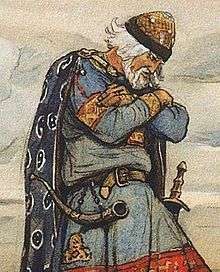 | Oleg the Seer[7] | ?–912 | 882 | 912 | Relation to Rurik is debatable | |
 | Igor I | ?–945 | 912 | 945 | son of Rurik I | |
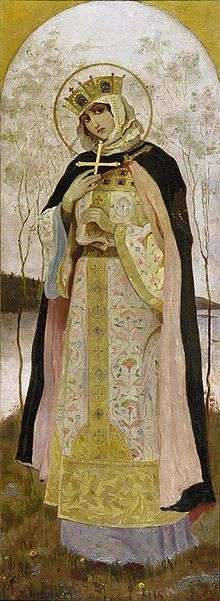 | St.Olga[8] | ?–969 | 945 | 962 | (regent-consort) | |
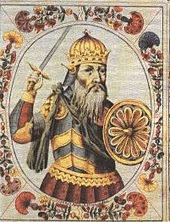 | Sviatoslav I[9] | 942–972 | 962 | 972 | son of Igor | |
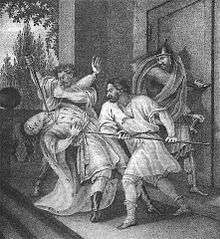 | Yaropolk I (Jaropolk)[10] | 958 (960?)–980 | 972 | 980 | One of the two Svyatoslav's sons |
Grand Princes of Kiev
Rurik Dynasty
| Portrait | Name | Branch | Born-Died | Ruled From | Ruled Until | Notes |
|---|---|---|---|---|---|---|
 | Vladimir I the Great | 958–1015 | 980 | 1015 | One of the two Svyatoslav's sons; in 988 baptized the Rus | |
| Sviatopolk I the Accursed [11] | 980–1019 | 1015 | 1019 | origin is debatable | ||
 | Yaroslav I the Wise | 978–1054 | 1019 | 1054 | son of Vladimir the Great, jointly with Mstislav in 1024–36 | |
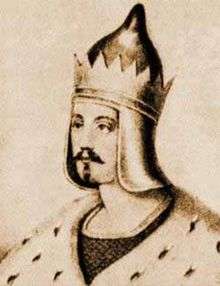 | Iziaslav I of Kiev | 1024–1078 | 1054 | 1073 | son of Yaroslav, first time (in 1068/69 lost state power to Polotsk princes) | |
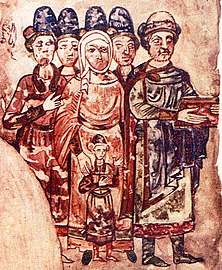 | Sviatoslav II of Kiev | 1027–1076 | 1073 | 1076 | son of Yaroslav | |
 | Iziaslav I of Kiev | 1024–1078 | 1076 | 1078 | second time, in 1075 Pope Gregory VII sent him a crown from Rome | |
 | Vsevolod I of Kiev | 1030–1093 | 1078 | 1093 | son of Yaroslav | |
| Sviatopolk II of Kiev | Izyaslavichi | 1050–1113 | 1093 | 1113 | son of Iziaslav I | |
 | Vladimir II Monomakh | Monomakhovychi | 1053–1125 | 1113 | 1125 | son of Vsevolod I |
.jpg) | Mstislav I the Great (Harald) | Monomakhovychi | 1076–1132 | 1125 | 1132 | son of Vladimir II |
 | Yaropolk II | Monomakhovychi | 1082–1139 | 1132 | 1139 | brother of Mstislav I |
| Viacheslav I | Monomakhovychi | 1083–1154 | 1139 | 1139 | brother of Yaropolk II (first time) | |
 | Vsevolod II | Svyatoslavichi | ?–1146 | 1139 | 1146 | son of Oleh Svyatoslavich |
 | Igor II | Svyatoslavichi | ?–1147 | 1146 | 1146 | brother of Vsevolod II |
 | Iziaslav II | Monomakhovychi | 1097–1154 | 1146 | 1149 | son of Mstislav I (first time) |
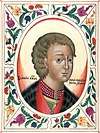 | Yuri I Dolgorukiy | Monomakhovychi | 1099–1157 | 1149 | 1151 | (first time) |
| Viacheslav I | Monomakhovychi | 1083–1154 | 1151 | 1154 | (second time) jointly | |
 | Iziaslav II | Monomakhovychi | 1097–1154 | (second time) jointly | ||
 | Rostislav I | Monomakhovychi | 1110–1167 | 1154 | 1154 | brother of Iziaslav II (first time) |
 | Iziaslav III | Svyatoslavichi | ?–1162 | 1154 | 1155 | (first time) |
 | Yuri I Dolgorukiy | Monomakhovychi | 1099–1157 | 1155 | 1157 | (second time) |
 | Iziaslav III | Svyatoslavichi | ?–1162 | 1157 | 1158 | (second time) |
 | Rostislav I | Monomakhovychi | 1110–1167 | 1158 | 1167 | (second time) jointly with Iziaslav III in 1162 |
 | Mstislav II | Izyaslavichi (Monomakh) | ?–1172 | 1167 | 1169 | son of Iziaslav II (first time) |
| Gleb | Yurievichi (Monomakh) | ?–1171 | 1169 | 1169 | son of Yuri Dolgorukiy (first time) | |
 | Mstislav II | Izyaslavichi (Monomakh) | ?–1172 | 1170 | 1170 | (second time) |
| Gleb | Yurievichi (Monomakh) | ?–1171 | 1170 | 1171 | (second time) | |
| Vladimir III | Monomakhovychi | 1132–1171 | 1171 | 1171 | son of Mstislav I the Great | |
| Michael I | Yurievichi (Monomakh) | ?–1176 | 1171 | 1171 | half-brother of Gleb | |
| Roman I | Rostislavichi (Monomakh) | ?–1180 | 1171 | 1173 | son of Rostislav I (first time) | |
| Vsevolod III the Big Nest | Yurievichi (Monomakh) | 1154–1212 | 1173 | 1173 | brother of Michael I | |
| Rurik II | Rostislavichi (Monomakh) | ?–1215 | 1173 | 1173 | brother of Roman I (first time) | |
| Sviatoslav III | Olgovichi | ?–1194 | 1174 | 1174 | son of Vsevolod II (first time) | |
| Yaroslav II | Izyaslavichi (Monomakh) | ?–1180 | 1174 | 1175 | son of Iziaslav II (first time) | |
| Roman I | Rostislavichi (Monomakh) | ?–1180 | 1175 | 1177 | (second time) | |
| Sviatoslav III | Olgovichi | ?–1194 | 1177 | 1180 | (second time) | |
| Yaroslav II | Izyaslavichi (Monomakh) | ?–1180 | 1180 | 1180 | (second time) | |
| Rurik II | Rostislavichi (Monomakh) | ?–1215 | 1180 | 1182 | (second time) | |
| Sviatoslav III | Olgovichi | ?–1194 | 1182 | 1194 | (third time) | |
| Rurik II | Rostislavichi (Monomakh) | ?–1215 | 1194 | 1202 | (third time) | |
| Igor III | Izyaslavichi (Monomakh) | ?–? | 1202 | 1202 | son of Yaroslav II (first time) | |
| Rurik II | Rostislavichi (Monomakh) | ?–1215 | 1203 | 1206 | jointly (fourth time) | |
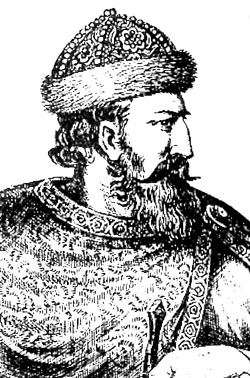 | Roman II the Great | Izyaslavichi (Monomakh) | 1160–1205 | son of Mstislav II, jointly (1203–05) | ||
| Rostislav II | Rostislavichi (Monomakh) | 1173–1214 | son of Rurik II, jointly (1204–06) | |||
| Vsevolod IV the Red | Svyatoslavichi (Olgovichi) | ?–1212 | 1206 | 1207 | son of Sviatoslav III (first time) | |
| Rurik II | Rostislavichi (Monomakh) | ?–1215 | 1207 | 1210 | (fifth time) | |
| Vsevolod IV the Red | Svyatoslavichi (Olgovichi) | ?–1212 | 1210 | 1212 | (second time) | |
| Igor III | Izyaslavichi (Monomakh) | ?–? | 1212 | 1214 | (second time) | |
| Mstislav III | Rostislavichi (Monomakh) | ?–1223 | 1214 | 1223 | son of Roman I | |
| Vladimir IV | Rostislavichi (Monomakh) | 1187–1239 | 1223 | 1235 | brother of Rostislav II | |
| Iziaslav IV | Siveria (Olgovichi) or Rostislavichi (Monomakh) | 1186–? | 1235 | 1236 | son of Vladimir Igorevich or Mstislav | |
.jpeg) | Yaroslav III | Yurievichi (Monomakh) | 1191–1246 | 1236 | 1238 | son of Vsevolod the Big Nest (first time) |
 | Michael II | Svyatoslavichi (Olgovichi) | 1185–1246 | 1238 | 1239 | son of Vsevolod IV (first time) |
Princes of Kiev (Mongol invasion)
Due to the Mongol invasion of 1240, Michael of Chernigov left Kiev to seek military assistance from the Kingdom of Hungary (Béla IV). During that time, the Prince of Smolensk Rostislav occupied Kiev, but was captured the same year by Daniel of Galicia who placed his voivode Dmytro to guard Kiev while the Grand Prince was away. Being unsuccessful in Hungary, Michael visited Konrad I in Masovia. Receiving no results in Poland, he eventually asked Daniel of Galicia for asylum due to the Mongol invasion.
| Portrait | Name | Branch | Born-Died | Ruled From | Ruled Until | Notes |
|---|---|---|---|---|---|---|
| Rostislav Mikhailovich | Smolensk (Rostislavichi) | 1210–1262 | 1239 | 1239 | son of Michael II | |
| Voivode Dmytro | 1239 | 1240 | appointed by Daniel of Galicia | |||
 | Michael II | Svyatoslavichi (Olgovichi) | 1185–1246 | 1241 | 1243 | (second time) |
.jpeg) | Yaroslav III | Yurievichi (Monomakh) | 1191–1246 | 1243 | 1246 | (second time) |
 | St. Alexander Nevsky | Vladimirsky (Monomakh) | 1220–1263 | 1246 | 1263 | son of Yaroslav III |
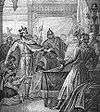 | Yaroslav IV | Vladimirsky (Monomakh) | 1230–1271 | 1263 | 1271 | brother of Alexander |
| Lev | Galicia (Monomakh) | 1228–1301 | 1271 | 1301 | son of Daniel | |
| Volodymyr-Ivan Ivanovich | Siveria (Olgovichi) | ?–? | 1301 | ? | ||
| Stanislav Ivanovich | Siveria (Olgovichi) | 1228–1301 | ? | 1321 |
Olshanski dynasty
Since the 14th century, the principality of Kiev started to fall under the influence of Grand Duchy of Lithuania. In 1299, the Metropolitan of Kiev Maximus moved his metropolitan see from Kiev to Vladimir-on-Klyazma. In 1321, after the battle on the Irpin River, Gediminas installed Mindgaugas, one of his subjects from the house of Olshanski, a descendant of the family of Vseslav of Polotsk that was exiled to the Byzantine Empire.
| Portrait | Name | Branch | Born-Died | Ruled From | Ruled Until | Notes |
|---|---|---|---|---|---|---|
| Mindaugas Holshanski | ?–? | 1321 | 1324 | son of Holsha Romanovich | ||
| Algimantas-Michael | ?–? | 1324 | 1331[12] | son of Mindaugas |
Rurik dynasty
In 1331, Kiev was once again taken by a member of the Rurik dynasty (Olgovich branch), the prince of Putivl.
| Portrait | Name | Branch | Born-Died | Ruled From | Ruled Until | Notes |
|---|---|---|---|---|---|---|
| Fyodor (Teodoras) | Siverski (Olgovichi) | ?–? | 1331 | 1362 | son of Ivan |
| Prince of Kiev | |
|---|---|
| Details | |
| First monarch | Vladimir V |
| Last monarch | Simonas |
| Formation | 1362 |
| Abolition | 1471 |
After the Battle of Blue Waters in 1362, Kiev and its surrounding areas were incorporated into the Grand Duchy of Lithuania by Algirdas, Grand Duke of Lithuania.
Gediminids
| Portrait | Name | Branch | Born-Died | Ruled From | Ruled Until | Notes |
|---|---|---|---|---|---|---|
| Vladimir V | ?–? | 1362 | 1394 | son of Algirdas | ||
 | Skirgaila | 1354–1397 | 1395 | 1397 | son of Algirdas |
Olshanski
| Portrait | Name | Branch | Born-Died | Ruled From | Ruled Until | Notes |
|---|---|---|---|---|---|---|
| Ivan | ?–? | 1397 | c. 1402 | son of Algimantas (in 1404–11 Jurgis Gedgaudas as voivode) | ||
| Andrew | ?–? | c. 1412 | c. 1422 | son of Ivan | ||
| Michael IV | ?–1433 | c. 1422 | c. 1432 | son of Ivan | ||
| Michael V Boloban | ?–1435 | c. 1433 | c. 1435 | son of Simonas |
Gediminas
| Portrait | Name | Branch | Born-Died | Ruled From | Ruled Until | Notes |
|---|---|---|---|---|---|---|
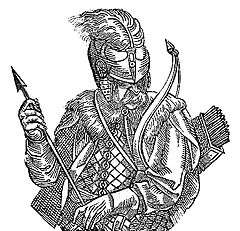 | Boleslav | 1370–1452 | 1432 | 1440 | son of Algirdas | |
| Alexander-Olelko | 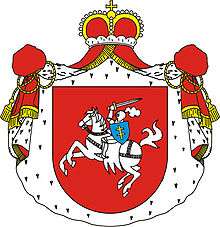 | ?–1454 | 1443 | 1454 | son of Vladimir | |
| Simon Olelkovich |  | 1418–1470 | 1454 | 1470 | son of Alexander |
See also
References
- Duczko, Wladyslaw (2004). Viking Rus: Studies on the Presence of Scandinavians in Eastern Europe. Koninklijke Brill NV, Leiden, The Netherlands. ISBN 90-04-13874-9
- Noonan, Thomas (2001). The Khazar Qaghanate and Its Impact on the Early Rus' State: The translatio imperii from Itil to Kyiv. Nomads in the Sedentary World, Anatoly Mikhailovich Khazanov and Andre Wink, eds. p. 76-102. Richmond, England: Curzon. ISBN 0-7007-1370-0
- Golden, Peter Benjamin (1982). The Question of the Rus' Qaganate. Archivum Eurasiae Medii Aevi. pp. 77–92
- Brook, Kevin Alan (1996–2009). An Introduction to the History of Khazaria
- Pritsak, Omeljan (1981). The origin of Rus. Cambridge, Mass.: Distributed by Harvard University Press for the Harvard Ukrainian Research Institute.
- Zuckerman, Constantine (2007). The Khazars and Byzantium – The First Encounter. In The World of the Khazars: New Perspectives – Selected Papers from the Jerusalem 1999 International Khazar Colloquium, eds. Peter Benjamin Golden, Haggai Ben-Shammai, and András Róna-Tas, pp. 399–432. Leiden, Netherlands: Brill.
- Sveerne (konung of Holmgård (Novgorod) and Kønugård (Kyiv))
- Olga was first of Rurikid to be baptized by Emperor Constantine VII but failed to bring Christianity to Kyiv
- Leszek Moczulski (2007). Narodziny Międzymorza. Bellona. p. 475.
- Ярополк is modern Ukrainian, Jaropełk is Polish, Jaropluk is Czech, Jaropelkas is Lithuanian, Iaropelkos is Greek, Jaropolk is German and Swedish.
- The Old Slavonic is Свѧтопълкъ in the Cyrillic alphabet, the modern Ukrainian is Святополк, Polish is Świętopełk, Czech is Svatopluk, and Slovak is Svätopluk. Reconstructed, his name is Sventopluk. More commonly, his name is given in its Latin and Frankish equivalents: Suentopolcus, Suatopluk, Zventopluk, Zwentibald, Zwentibold, Zuentibold, or Zuentibald.
- "Розділ 4.1. Леонтій Войтович. Князівські династії Східної Європи". izbornyk.org.ua. Retrieved 12 April 2018.